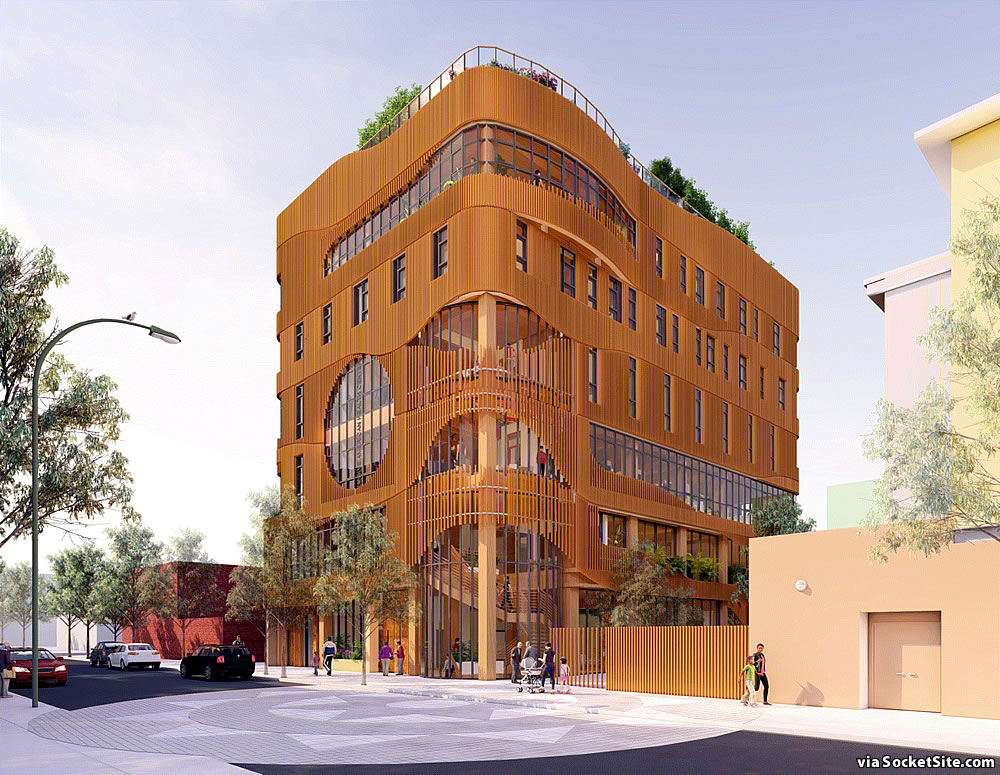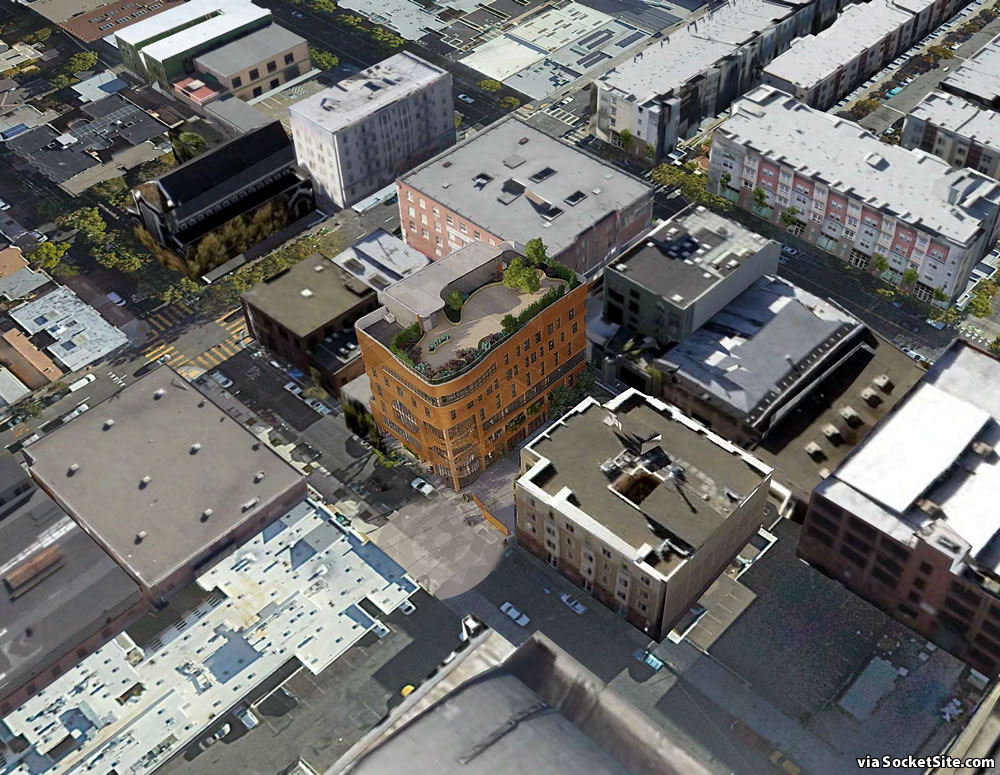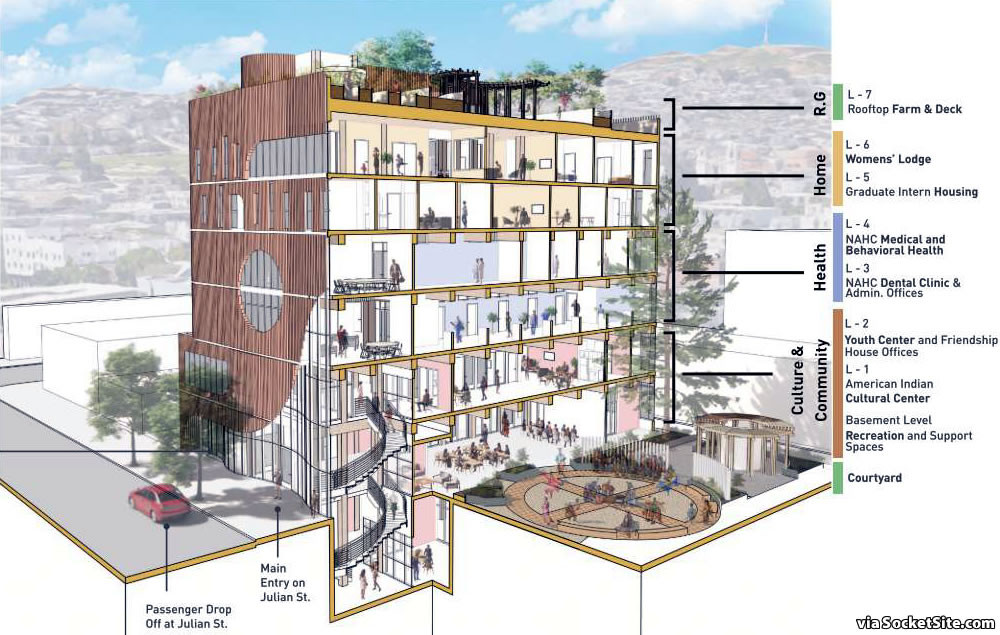As designed by PYATOK Architects for the Friendship House Association of American Indians, a modern six-story building dubbed the “Village SF” is proposed to rise up to 79 feet in height on the mostly vacant lot adjacent to the existing Friendship House building at 56 Julian Avenue in the Mission.
Envisioned as a highly visible, cultural, spiritual and community nexus for urban American Indians and Native organizations, the 43,000-square-foot Village would not only serve as the headquarters for the San Francisco American Indian Cultural District and provide a large gathering and exhibit area for the San Francisco American Indian Cultural Center, but would yield a host of supportive and social services, including healthcare, counseling and educational services, with 21 rooms of transitional housing and a green roof with a common space and vegetable garden.
And while the proposed Village still needs to be approved by San Francisco’s Planning Commission and Board of Supervisors, and a Special Use District for the site will need to be approved in order to exceed the existing 45-foot height limit for the site, the plans are slated to be granted a reprieve from having to complete an extensive environmental review. We’ll keep you posted and plugged-in.



wow, this is beautiful
That’s an ambitious design- I hope it doesn’t loose too much through value engineering. I’m a little over the now ubiquitous Corten steel exterior, if that’s what it is.
It’s actually a terracotta baguette facade, as designed.
I would have thought terracotta baguettes were a hazard during earthquakes, but the promo literature says otherwise.
So long as they’re installed correctly they should be OK. But if the builder screws up they could fall off even without an earthquake.
I was wondering more about the suspended tubes shattering. I suppose in any quake strong enough to cause that, we’d have much bigger problems to worry about.
How exactly is that part of town a Native American cultural district? This is a fiction that has been sponsored by a non-profit power grab over land use. Of all people SocketSite should know the skinny on this.
“Founded on March 31st, 2020, the American Indian Cultural District (AICD) is the first established Cultural District of its size in the United States dedicated to recognizing, honoring, and celebrating the American Indian legacy, culture, people, and contributions.”
History of the American Indian Center in the Mission.
I’m about the last person to jump on the “We are on native land” bandwagon, but … seriously? One of the most decimated and forgotten ethnic groups in the country, and you’re quibbling that there aren’t enough Native residents in the area to make it a “district”?!
How about the genocidal colonial land grab and occupation over the last two-plus centuries? This is a beautiful building in a location that needs it desperately. Beat up on greedy real estate developers, not on community nonprofits.
Exactly! What Mission Urbanist said.
The nonprofits in SF are the primary vehicle for corruption and land grabbing being blatantly abused under the guise of minority/art groups. If you don’t think there aren’t specific developers in on this game, you’re clueless. The Mission is dominated by these organizations and handful of developers they’ll approve projects to be developed by – the city is completely complicit in this con. Speaking of genocide, SF streets are full of people dying from Fentanyl ODs. Who supports the causes for homeless and drug addicts? Non profits!
Why the vitrol? Are you and “unlivablecity” developers, flippers, or some other hanger-on in the SF real estate “game” trying to profit from the runaway gentrification in The Mission or do you just feel strong class affinity for other members of the petite bourgeoisie who are?
This project proposed by a non-profit is not going to stop you from making your money.
The notion that some random racial “identity” group can lay claim to controlling land use in any neighborhood in San Francisco is absurd and probably unconstitutional. Worse still, in this case there was never any genuine “indigenous” backing. Calle 24 was told they couldn’t expand all the way to Division so they cooked up this ridiculous facade. It’s a scam that takes away the rights of property owners. Wake up
They don’t dictate or control land use over the neighborhood. Head over to Nextdoor with the rest of the racists.
From the legislation to establish the cultural district, as linked above:
Which brings us back to the plans and proposed building at hand…
Clearly, when the Spanish situated Mission Dolores where they did, it was not to exploit the indigenous people by the creek, but rather if was a crafty plan to limit property rights in the north Mission two hundred and fifty years in the future by creating a formidable network of omnipotent non-profits which would – and now does! – oppress and harass the great men and women whose only crime is to wanting to improve the formerly relatively affordable neighborhood by converting it into a vast expanse of luxury lofts and microstudios for now- and soon-to-be-unemployed symbol manipulators.
Whoa! That is a gorgeous building. Hope this makes it through planning and we get this version!
Gorgeous building…..which floor will house the Casino?
Cool building as proposed, interesting story behind it, and kudos to our intrepid socketsite editor for surfacing the underlying context.
Super cool design and if it helps people, even better.